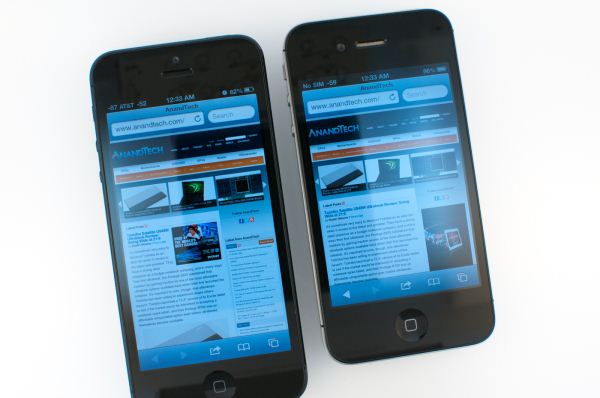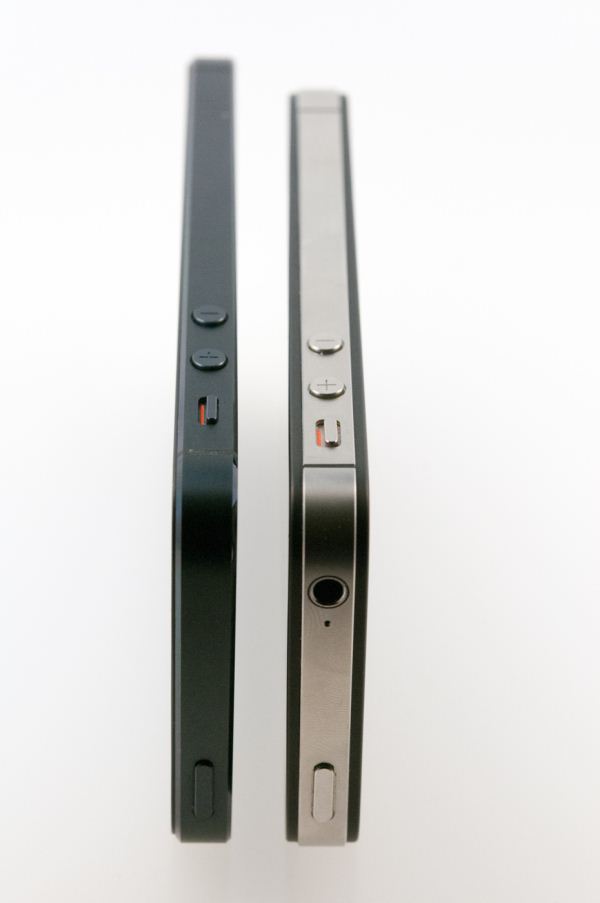The iPhone 5 Review
by Anand Lal Shimpi, Brian Klug & Vivek Gowri on October 16, 2012 11:33 AM EST- Posted in
- Smartphones
- Apple
- Mobile
- iPhone 5
The last significant redesign of the iPhone platform came in 2010 with the iPhone 4. It was an update that literally touched all aspects of the device, from SoC to display to baseband and of course, chassis. Last month’s launch of the iPhone 5 is no different in magnitude. The sixth generation iPhone makes some of the biggest changes to the platform since its introduction in 2007.
Visually the device begins by evolving the design language of the iPhone 4/4S chassis. From the launch of the iPhone 4 it was quite obvious that Apple had picked a design it was quite proud of. Thus it’s not too surprising that, from a distance, the iPhone 5 resembles the previous two iPhone models. We’ll get into material differences shortly, but what make the iPhone 5 design such a radical departure is its larger display.
All previous iPhones have maintained the same 3.5-inch, 3:2 aspect ratio display. With the rest of the world quickly moving to much larger displays, and with 16:9 the clear aspect ratio of choice, when faced with the decision of modernizing the iPhone platform the choice was obvious.
The iPhone 5 embraces a taller, 4-inch, 16:9 1136 x 640 display opting to lengthen the device instead of increasing its area in both dimensions. The result is a device that is distinctly an iPhone, albeit a modern one. The taller display doesn’t do much to make desktop web pages any easier to read as a result of the width staying the same. Those longing for an HTC One X or Galaxy S 3 sized device running iOS are out of luck. Reading emails and typing are both improved though as there’s now more room for lists and the keyboard no longer occupies as much of the display. The taller device can be more awkward to use if you have smaller hands, but the added screen real estate is honestly worth it. Once you get used to the iPhone 5’s display, going back to the older models is tough.
The taller chassis went on a diet as well. The iPhone 5 is now considerably thinner and lighter than its predecessor, which is yet another factor that contributes to it feeling more modern.
Internally the device changes are just as significant, if not more, than those on the outside. The iPhone 5 includes LTE support, which in areas where LTE networks are deployed can be enough reason alone to warrant an upgrade.
The iPhone 5 also includes a brand new SoC from Apple: the A6. For the first time since the introduction of the iPad, Apple has introduced a major branded SoC on an iPhone first. The iPhone 4 used the A4 after it debuted on the iPad, and the 4S picked up the A5 months after the iPad 2 launched with it. The A6 however arrives first on the iPhone 5, and with it comes two of Apple’s first, custom designed CPU cores. We’ve always known Apple as a vertically integrated device and software vendor, but getting into CPU design takes that to a new level.
| Physical Comparison | ||||
| Apple iPhone 4S | Samsung Galaxy S 3 (USA) | HTC One S | Apple iPhone 5 | |
| Height | 115.2 mm (4.5") | 136.6 mm (5.38" ) | 130.9 mm (5.15" ) | 123.8 mm (4.87") |
| Width | 58.6 mm (2.31") | 70.6 mm (2.78") | 65 mm (2.56") | 58.6 mm (2.31") |
| Depth | 9.3 mm ( 0.37") | 8.6 mm (0.34") | 7.8 mm (0.31") | 7.6 mm (0.30") |
| Weight | 140 g (4.9 oz) | 133g (4.7 oz) | 119.5g (4.21 oz) | 112 g (3.95 oz) |
| CPU | Apple A5 @ ~800MHz Dual Core Cortex A9 | 1.5 GHz MSM8960 Dual Core Krait | 1.5 GHz MSM8260A Dual Core Krait | 1.3 GHz Apple A6 (Dual Core Apple Swift) |
| GPU | PowerVR SGX 543MP2 | Adreno 225 | Adreno 225 | PowerVR SGX 543MP3 |
| RAM | 512MB LPDDR2-800 | 2 GB LPDDR2 | 1 GB LPDDR2 | 1 GB LPDDR2 |
| NAND | 16GB, 32GB or 64GB integrated | 16/32 GB NAND with up to 64 GB microSDXC | 16 GB NAND | 16, 32, or 64 GB integrated |
| Camera | 8 MP with LED Flash + Front Facing Camera | 8 MP with LED Flash + 1.9 MP front facing | 8 MP with LED Flash + VGA front facing | 8 MP with LED Flash + 1.2MP front facing |
| Screen | 3.5" 960 x 640 LED backlit LCD | 4.8" 1280x720 HD SAMOLED | 4.3" 960x540 Super AMOLED | 4" 1136 x 640 LED backlit LCD |
| Battery | Internal 5.3 Whr | Removable 7.98 Whr | Removable 6.1 Whr | Internal 5.45 Whr |
There’s a lot to talk about when it comes to the new iPhone. Whether it is understanding the architecture of the A6 SoC or investigating the improved low light performance of the iPhone 5’s rear facing camera, we’ve got it here in what is easily our most in-depth iPhone review to date. Let’s get started.












276 Comments
View All Comments
dagamer34 - Tuesday, October 16, 2012 - link
Yeah, when are we going to see PowerVR 6?ltcommanderdata - Tuesday, October 16, 2012 - link
I think it's expected mid-2013, so it would have been a big stretch to have made it for the iPhone 5. Apple didn't really have that much choice with sticking to the SGX543MP since happened to be off cadence. Even making it for the iPad 4 might be iffy.peat - Tuesday, October 16, 2012 - link
I was pushed to see the 'considerable' difference between the thickness of the iP4 and iP5 in the pic. Looking at the dimensions in the table it's thinner by a truly staggering 11%.Q. Since when has an 11% change in anything equated to "considerable". But yup, I still want one.
darwinosx - Tuesday, October 16, 2012 - link
To anyone who knows anything about smartphone design and what goes into the device.Alucard291 - Tuesday, October 16, 2012 - link
No offence but to a consumer that's still 11%. I.e. not even 1/5 reduction.What I'm trying to get at here is that its negligible to most users and touting it as an improvement is only marketing blurb.
Sufo - Tuesday, October 16, 2012 - link
IRL i've noticed the reduction, you'd be surprised how good your hands are at picking up (forgive the pun) on these things. Still, it's not a huge change, admittedly, and it was almost mandatory with the increase in height. Nevertheless once again a nice device to hold.doobydoo - Friday, October 19, 2012 - link
Exactly.If you actually try holding an iPhone 5 you'll immediately notice how obvious it is that it's significantly thinner and lighter.
And as someone else said - it's 18% thinner, not 11.
Kidster3001 - Monday, October 22, 2012 - link
really dooby?From someone who has always said 4" was way to big and 3.5" was perfect? Now you like 4" displays?
Aenean144 - Tuesday, October 16, 2012 - link
Since when does (1 - 7.6/9.3) = 11%?My calculator says the iPhone 5 is 18% thinner than the iPhone 4.
edsib1 - Tuesday, October 16, 2012 - link
Your android benchmarks are meaningless if you dont use a) best browser and b) latest drivers. Phones with later version drivers will have higher scores.HTC One X (Tegra3) - official RUU 4.04 & Chrome
Kraken - 21095
Google V8 - 1578
Octane V1 - 1684
Sunspider - 1172
Browsermark - 130288
HTC One X (Tegra3) - Eternity Kernel (3.4) & Chrome
Kraken - 18750
Google V8 - 1791
Octane V1 - 1922
Sunspider - 1084
Browsermark - 162580